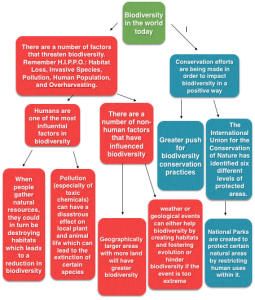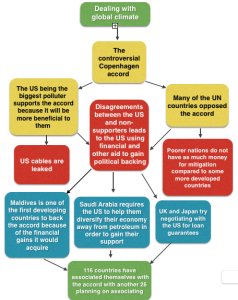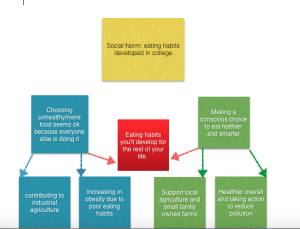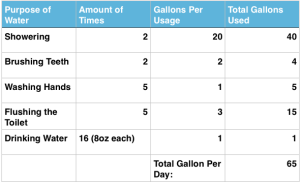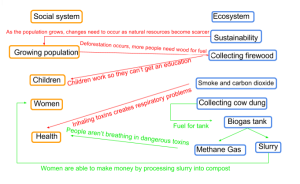Part 1. Draw a systems diagram representing the state at which biodiversity is changing today. Be sure to include detailed information about the reduction/conservation of biodiversity and how these factors effect it. The diagram should have at least six system components and the arrows should point in a logical direction and be explained.
Part 2. In a paragraph of 250-350 words, explain the ideas behind your diagram and connect these ideas with concepts you learned from other modules.
Part 3. In another paragraph of 250-350 words, present an example of a threat that effects biodiversity in your hometown and what steps could be taken to reduce this threat.
2. Biodiversity plays a crucial role in the future of sustainability, this is why we must continue our efforts to conserve the environment in order for biodiversity to thrive around the world. In my diagram above I have shown some of the problems concerning the reduction of biodiversity and the steps that have been taken in order to reverse these effects. The diagram uses contrasting red and blue text blocks to depict the problems (red) and solutions (blue). The first red block closest to the top gives a general overview of the main issues negatively effecting biodiversity. I then broke the main block down into two categories, human and non-human factors. Each of these categories contain specific examples of human and non-human factors and how exactly they are impacting biodiversity. On the other side of the diagram I have the blue blocks containing information on the conservation efforts to help grow biodiversity. Some of these efforts include a stronger push for conservation through which people use the idea a collective action to help raise awareness of reduced biodiversity around the world. Another catalyst in this conservative movement is the work The International Union for the Conservation of Nature has been doing. They’ve created a systematic scheme of the different levels of protected areas and what each of those areas means in terms of what they do for conservation. However, in order for these conservative efforts to have a greater effect, more of us need to acquire an ecocentric mindset. We can continue to develop as a species but we need to learn how to do it in such a way that protects habitats and other ecosystems while trying to gather the resources we need in order to thrive.
3. Anyone who has lived in or visited Pennsylvania, especially during the summertime, will probable be familiar with some of the many bugs that call this state home. Most bugs play an important role in the food chain and even agriculture but there is one species in particular that seems to be doing more harm then good. The Brown Marmorated Stink Bug or stink bug for short is an example of an invasive species that has been impacting biodiversity in Pennsylvania. Originally found throughout East Asia, it is speculated that the stink bug was brought over to the U.S through shipping materials and was first discovered in the late 1990s in Allentown Pa. In module 10 we learned about some of the dangers invasive species can pose to biodiversity and what it could mean if that problem isn’t dealt with. Stink bugs have been known to feed on a variety of plants, including fruit trees, ornamentals, and various other crops. Since the stink bug has no natural predators here in the U.S, they can continually cause damage to locally grown produce. So the question remains, what can we do about these pesky insects. Insecticides are one option but why spread more chemicals into the environment when there are other ways to deal with them. I have known farmers who have used mineral clay as a means of preventing stink bugs from both laying eggs and feeding on crops. Another effective way to get rid of stink bugs are to buy stink bug traps. We have used some of these traps around my home and I was amazed at how many these things could hold, there must have been hundreds of stink bugs in each one. The nice part about stink bug traps is that they aren’t polluting the environment with toxic chemicals and they are made to only attract stink bugs.

